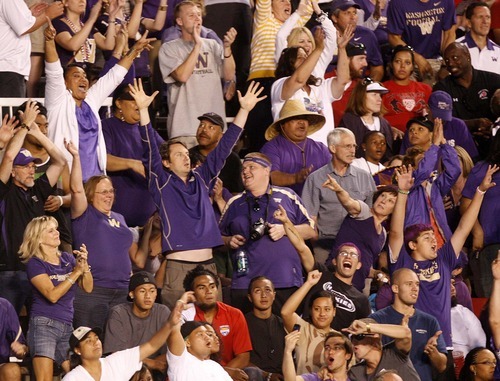This is an archived article that was published on sltrib.com in 2012, and information in the article may be outdated. It is provided only for personal research purposes and may not be reprinted.
A study commissioned by the University of Utah has concluded the school's first football season in the Pac-12 paid dividends to the state in terms of measurable economic impact.
Ute football's contribution to the state's economy jumped by 60 percent last fall, accounting for 210 jobs, according to the report released by the Center for Public Policy & Administration. Half of that impact was attributed to television revenue that comes with playing high-profile West Coast teams, such as the USC Trojans and Washington Huskies.
But fans of opposing teams came to Salt Lake City in far greater numbers this year, more than doubling from 546 per game on average to 1,272, injecting a few million additional dollars into the local economy.
"Visitors spent $5.5 million during the five Pac-12 home games last season. Not only did they spend money here, they are more likely to return to our state," said David Rudd, a former NCAA player who is now dean of the U.'s College of Social and Behavioral Science. "Being part of the Pac-12 is a significant boost to our state's economy."
This spending generated more than $500,000 in tax revenue for the state.
The findings did not surprise Utah tourism promoters, who are familiar with the power of big-time sports to pull tourists into the state.
"It's clearly logical when you look at the culture that is UCLA football versus, say, New Mexico. It is easy to see why we have more travelers. These are successful [football] programs — they have great alumni who are very active," said Scott Beck, president and CEO of Visit Salt Lake.
He added that one aspect of the economic benefit is difficult if not impossible to quantify, so it does not get much attention in the U. report.
Whenever a home Pac-12 game is nationally televised, images of the Wasatch Mountains and the Salt Lake Valley beam into countless living rooms and bars, exposing a vast out-of-state audience to Utah scenery.
"Earned media is a powerful tool, and it's totally intangible," Beck said. "The commentators are sitting there in the booth at Rice-Eccles Stadium looking at the Wasatch in total awe and camera pans over. That's an incredible image. No one in the state can buy that."
For the study, U. students surveyed 321 out-of-state attendees at Utah's five home Pac-12 games, eliciting information about their spending habits and perceptions of Utah. These young researchers visited tailgate parties, transit stations and downtown hotels where opposing schools' fans were gathered during game weekends.
"You can always tell the fans by the colors they wear," said Jennifer Robinson, the CPPA director.
The study, written by research analyst Michael Hogue of the U.'s Bureau of Economic and Business Research, broke down spending by various fan groups, with the biggest spenders rooting for the Oregon State Beavers. The 1,901 Washington fans who attended the Oct. 1 game stayed for an average of 3.2 days, spending $87 per day on lodging and $88 on food. Nearly three-fourths stayed in a hotel, and 57 percent arrived by plane.
Per-day spending ranged, on average, from $186 for Colorado fans (whose team barely beat Utah) to $295 for Oregon State fans (whose team got smoked). Visitors stayed an average of just over three days. Nearly three-fourths of first-time visitors said they were more likely to come back to the Beehive State, Hogue wrote, while 87 percent of those who had visited before said they were more likely to return.
"That number is awesome. They came for football, and now they'll come back for other reasons," Robinson said. "They get downtown and see how beautiful it is. It's a clean city, and the people are nice. Everything is so convenient for them: There are restaurants, clubs and transportation to the stadium. They come for a couple of days, and it gives them a chance to get to know the city."
Still, tourist spending pales in comparison with the broadcast revenue the U. is expected to reap as a result of Pac-12 membership. This year the U. should earn $3 million in television revenue, but its slice of the broadcast pie will step up each of the next few years, hitting as much as $15 million in 2015.
This fall, Utah hosts four Pac-12 games: USC on Oct. 4; Cal on Oct. 27; Washington State on Nov. 3; and Arizona on Nov. 17.
"The plan is to repeat it the next few years," Robinson said. "We believe [increased out-of-state attendance] will hold true if the economy gets better and people are willing to travel."
College football's economic impact
A University of Utah study has found visitors who came to the Beehive State for Pac-12 football last fall spent $5.5 million, a 60 percent jump from previous seasons, when the Utes played in the Mountain West.



